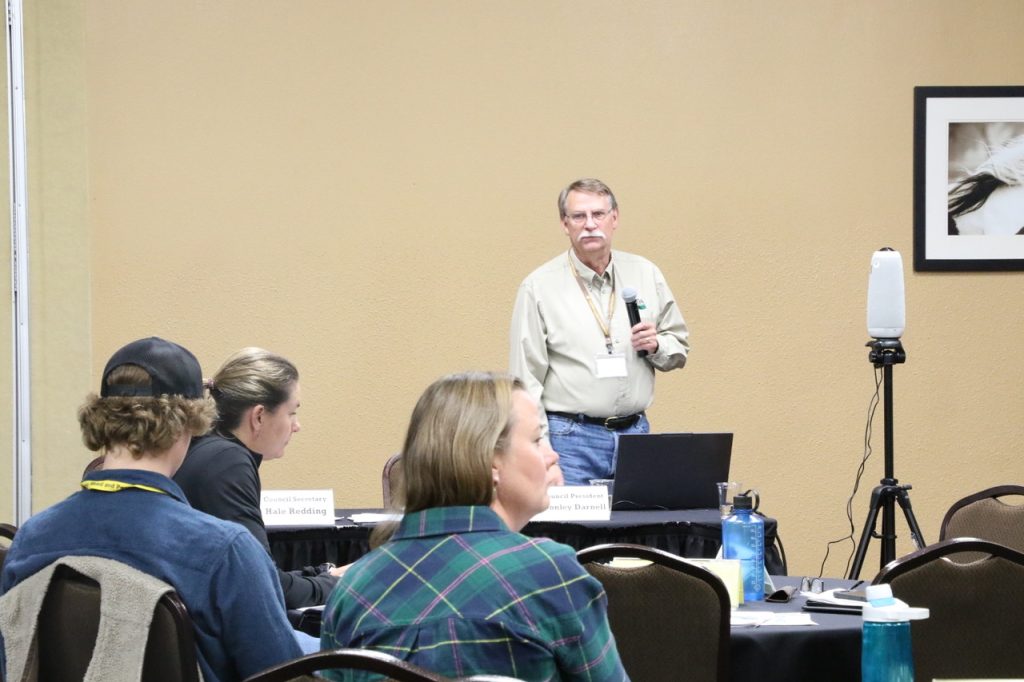Keeping Wyoming Wild and Beautiful: Wyoming Weed and Pest Council hosts fall conference

For more than 70 years, the Wyoming Weed and Pest Council (WWPC) has been organizing an annual conference to unite its 23 districts and advance the organization’s mission of safeguarding Wyoming’s agricultural lands and open spaces from invasive species.
On Oct. 29-31, individuals gathered at the Ramkota Hotel and Conference Center in Casper to attend the WWPC’s 80th Annual Conference.
During the three-day event, participants engaged in various activities such as training sessions, business meetings, historical presentations and legislator roundtables.
The conference is an excellent opportunity for individuals to expand their knowledge, establish connections and enjoy camaraderie with fellow professionals.
The WWPC’s efforts and commitment ensures Wyoming remains a beautiful and pristine environment for outdoor enthusiasts and landowners.
With a district office in each county, the work conducted within these districts is essential for fulfilling the mission of managing noxious weeds and pests and contributing to the preservation of Wyoming’s natural beauty.
Opening events
To kick off the fall convention, attendees had the opportunity to hear from Keynote Speaker Russell Hawley, Casper College Tate Museum education specialist.
Following Hawley, WWPC jumped into their first business meeting, which included area updates and committee reports.
After a quick budget review and discussion about bylaws, University of Wyoming (UW) College of Agriculture, Life Sciences and Natural Resources Associate Professor Timothy Collier presented UW’s annual weed biological control report.
Collier was joined by UW Department of Plant Sciences Assistant Professor and Extension Weed Specialist Dr. Kelsey Brock who updated attendees on the Early Detection and Rapid Response (EDRR) program.
EDRR is an important weed management strategy which utilizes a variety of surveying methods to detect new invasive species.
After a quick break, U.S. Department of Agriculture (USDA) Animal and Plant Health Inspection Service Wyoming State Plant Health Director Bruce Shambaugh gave a report on the agency’s current projects, including an update on the spongy moth, previously known as the gypsy moth; potato cyst nematodes and staffing updates.
Convention continues
To begin the second day of convention activities, attendees were provided with a closer look into the Early Detection and Distribution Mapping System (EDDMapS).
University of Georgia (UGA) Director of the Center for Invasive Species and Ecosystem Health Chuck Bargeron explained EDDMapS is a web-based mapping system for documenting invasive species and pest distribution.
According to Bargeron, the system is fast, easy to use and doesn’t require geographic information systems experience.
Launched in 2005, it was originally designed as a tool for state Invasive Plant Councils to develop more complete distribution data of invasive species.
Since then, the program has expanded to include the entire U.S. and Canada, as well as to document certain native pest species.
“EDDMapS’s goal is to maximize the effectiveness and accessibility of the immense numbers of invasive species and pest observations recorded each year,” Bargeron stated.
As of February 2023, EDDMapS has over 7.5 million records and aggregate data from other databases and organizations, as well as volunteer observations to create a national network of invasive species and pest distribution data which is shared with educators, land managers, conservation biologists and beyond.
He continued, “This data will become the foundation for a better understanding of invasive species and pest distribution around the world.”
“The goal of EDDMapS is to maximize the effectiveness and accessibility of the immense numbers of invasive species observations recorded each year,” Bargeron concluded.
Closing remarks were made and the morning educational session ended when WWPC Employee Association President Jake Jarrett took to the podium to conduct the annual employee meeting.
The afternoon business session was launched by WWPC area representatives from Natrona, Converse, Weston and Niobrara counties who presented updates of their respective areas and current invasive weed activity.
Next up to present was WWPC Teton County Assistant Supervisor Mark Daluge who gave an introduction to utilizing drone programs and the benefits which accompany drone usage for weed and pest control.
“They are more efficient than doing treatments by hand,” Daluge stated. “There are areas in our county which we could not treat if we did not have the ability to use a drone. Plus, using a drone allows for uniformity in treatment and allows for better recordkeeping.”
Closing the convention
Bargeron closed out the second day of the convention with a presentation on ways to think differently about detecting and reporting invasive species.
He introduced a new resource called Wild Spotter, a program to build citizen science volunteer capacity to protect America’s wild places from harmful invasive plants, vertebrates, invertebrates, microbes, algae and fungi which outcompete the nation’s native species and threaten the biodiversity and health of every aquatic and terrestrial ecosystem.
“Wild Spotter helps individuals identify, map and report invasive species found in their favorite wild places,” he explained.
Wild Spotter is a partnership between the UGA, USDA Forest Service and Wildlife Forever, and it is currently available for all national forests and grasslands, with hopes to expand to all public lands.
“It’s not just an app, it’s an entire campaign,” Bargeron said. “We have to get the public involved and have them assist in keeping our counties free of invasives. Now, thanks to the app, citizen scientists can help researchers track and stop the spread of invasive species by reporting and mapping sightings of them.”
“It is impossible for agencies like yourself to monitor all of the lands. Reaching the public, who are in these specific areas across the country, is a solution to help find new infestations before they spread,” Bargeron concluded.
Melissa Anderson is the editor of the Wyoming Livestock Roundup. Send comments on this article to roundup@wylr.net.





